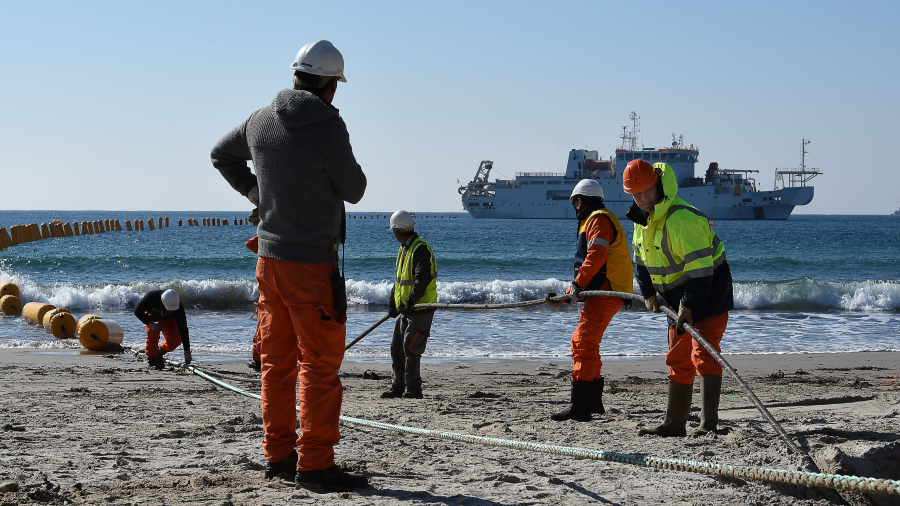The submarine infrastructure linking the world’s communication networks

This week, a repair team is set to help restore Tonga’s internet after a volcanic eruption and tsunami last month severed the country’s primary communication connection to the rest of the world: a submarine cable, one of many that crisscross the floors of oceans and seas around the planet.
In fact, if you’re listening to this outside of the U.S., this episode itself has traveled along a cable (or multiple cables) at the bottom of the ocean to make its way to you. Around 95% of global telecommunications run through fewer than 500 cables.
To unpack this technology, I’m joined by Alan Mauldin. He’s a research director for TeleGeography, a market research and consulting firm. The following is an edited transcript of our conversation.
Alan Mauldin: So it might be a surprise to many people, but the vast, vast majority of all international communications is traveling on fiber optic cables across land and under the ocean. So it’s not going through the air, and it’s not going over a satellite. It’s going, physically, over fiber.
Kimberly Adams: Particularly over fiber under the sea. Can you talk about the global infrastructure of these undersea cables?

Mauldin: Submarine cables are indeed the dominant way that all types of telecom traffic is carried between continents all over the world, whether it’s, it’s a webpage, a Zoom call, whatever, it’s all being carried under these cables. And most countries have many different cables to provide a very resilient and robust network, so that if there is damage to one cable, data can flow then over alternate paths.
Adams: Why is it that places like Tonga just have the one major connection, but, say, parts of France might have something like seven?
Mauldin: It’s economics, really. Cables are very expensive to build and operate, and given the demand requirements for Tonga, they’re able to use one cable in conjunction with a satellite solution to provide a pretty good level of service.
Adams: Who builds and controls this infrastructure?
Mauldin: So traditionally, the primary companies that built cables were the telecom carriers — companies like Orange in France or AT&T, who would join together as part of a consortium. Increasingly, though, the biggest change in the last decade is we’re seeing companies like Google and Facebook, especially, who have gotten into this as well. They want to have the lowest cost per bit to send data around the world. And cables offer that.
Adams: You have people like Elon Musk investing in Starlink technology, using satellites for global communication, but companies like Meta and Google are continuing to put money into the subsea cable industry. Why is that?
Mauldin: Satellites that are being built by Elon Musk, and Jeff Bezos with his Kuiper project with Amazon, they are not trying to replace cables, or do what cables do. The purpose of these systems is to provide a way to reach under-served or totally unserved parts of the world where there is no access to high speed broadband service presently. So the capacity of something like a Starlink is in no way able to replace the capacity of what a submarine cable can offer.
Adams: Looking ahead to the future, what developments in this particular segment of global infrastructure are you the most excited about? Is there something new coming down the proverbial pipeline?
Mauldin: The biggest development we’re seeing right now is really an investment, globally, to build in new paths, higher capacity path. The demand for data, it’s not slowing, it keeps on growing. We have to constantly invest, to build new cables to handle the data, but also more different paths that follow different routes. Because cables do tend to break all the time, all over the world and you never usually hear about it, because if there’s a fault on one cable, the other cables can carry what that cable carried and there’s almost no way for a user to discern that there has been a cable fault.

Related Links: More insight from Kimberly Adams
If, like me, you decide to go deep down the rabbit hole of the world of undersea cables, check out TeleGeography’s “Frequently Asked Questions” page. TeleGeography also has an interactive map on its website, so you can trace the path of information across the globe.
Here’s a Wall Street Journal article with a detailed breakdown of the private, Big Tech investment going into submarine cables.
And a Reuters piece that explains what it will take to fix the damaged cable. It includes an interesting graphic showing all the layers of submarine internet cables — cables which can be as narrow as a garden hose, in many places. Plus an illustration of what the repair ship looks like.
The ship on the job in Tonga, the CS Reliance, is one of just 59 vessels in operation that can lay and fix the cables that keep our world connected under the sea.
The future of this podcast starts with you.
Every day, the “Marketplace Tech” team demystifies the digital economy with stories that explore more than just Big Tech. We’re committed to covering topics that matter to you and the world around us, diving deep into how technology intersects with climate change, inequity, and disinformation.
As part of a nonprofit newsroom, we’re counting on listeners like you to keep this public service paywall-free and available to all.
Support “Marketplace Tech” in any amount today and become a partner in our mission.












